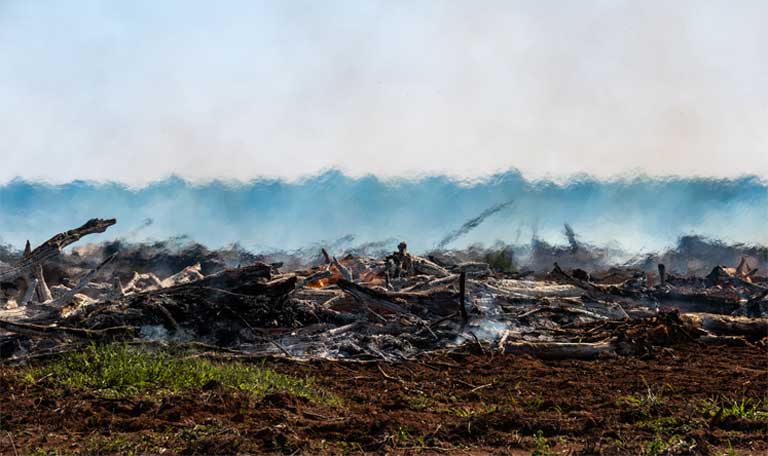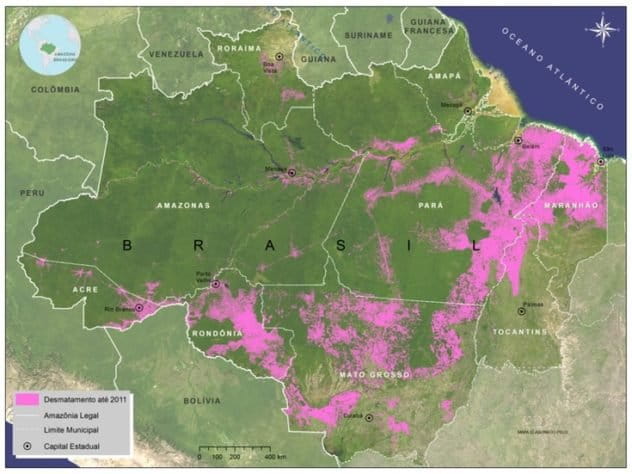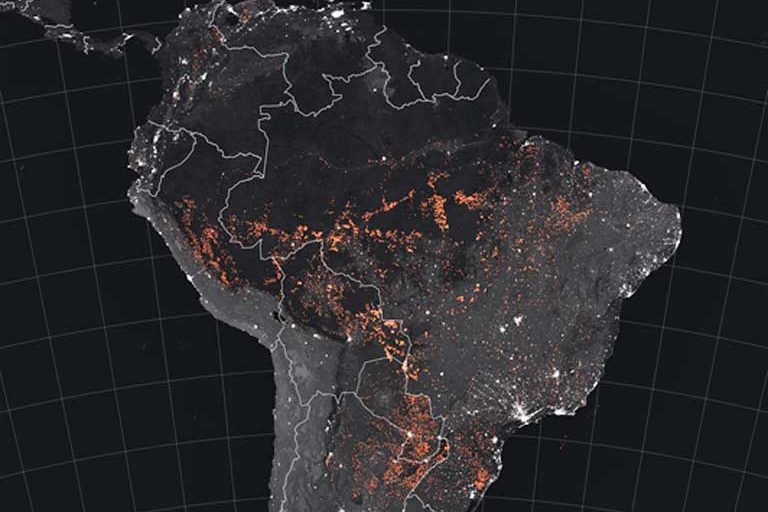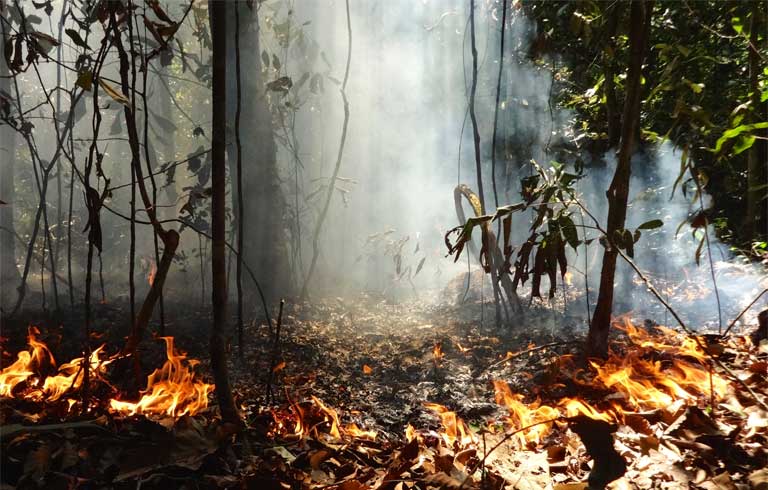- A new study finds that the Brazilian Amazon could be moving from being a carbon storehouse to a carbon source — putting the regional and global climate at great risk. Intensifying wildfires could contribute to that shift happening by mid-century.
- Researchers used models to show that an increasingly hot, dry Amazon climate, coupled with deforestation, could trigger wildfires burning up to 16% of the rainforest in Brazil’s Southern Amazon by 2050, releasing up to 17 billion metric tons of carbon dioxide.
- The team’s models indicated that Amazon fires will likely continue intensifying before 2030, due to more frequent heat and drought conditions caused by global warming, and as rampant deforestation due to agribusiness expansion dries out the understory and creates more flammable forest edges.
- Of great concern, the study also found that over time, fires won’t just impact edge areas, but intact forest, deep inside indigenous reserves and other conserved areas. Reduced sources of fire ignition and fire suppression could decrease the likelihood of burning, especially if accompanied by a decrease in global carbon emissions.

Global temperatures continued their relentless rise last year, with 2019 the second hottest year on record, according to NASA and NOAA, the National Oceanic and Atmospheric Administration. Along with the heat and accompanying drought, came firestorms that consumed vast tracts of forest on four continents.
In the Brazilian Amazon, fires burned at least 125,000 hectares (310,000 acres) in August, 2019, blackening the sky at noon more than a thousand miles away in South America’s largest city Sao Paulo, and gaining global attention.
But worse may be yet to come, according to Paulo Brando, an ecosystem scientist at the University of California, Irvine, and his team who have published a study in Science Advances entitled The gathering firestorm in southern Amazonia.
Using models, the researchers found that an increasingly hot, dry Amazon climate, coupled with deforestation, could trigger wildfires burning up to 16% of the Southern Amazon rainforest in Brazil by 2050, releasing up to 17 billion metric tons of carbon dioxide and possibly shifting the Amazon rainforest from being a carbon sink to a major carbon emitter.
The researchers did find reason for hope: their models showed that deforestation prevention could reduce burned forest area by up to 30% and cut greenhouse gas emissions from fires by 56% in the region.
“Aggressive efforts to reduce sources of fire ignition and suppress unwanted fires could reduce the likelihood of burning large tracts of Amazonian forests, including protected areas and indigenous reserves,” Brando’s team wrote. “These actions will be most effective if accompanied by a global decrease in greenhouse gas emissions.”
The increased loss of stored Amazon carbon to the atmosphere between now and 2050 has serious implications for a world urgently seeking to curb emissions and cataclysmic climate change impacts.

Fire, climate change and deforestation driving carbon release
The research team’s models indicated that Amazon fires will likely continue intensifying before 2030, due to more frequent heat and drought conditions caused by climate change, and as rampant deforestation due to agribusiness expansion dries out the understory and creates more flammable forest edges. This escalation is expected even if global greenhouse gas emissions are reduced, which seems unlikely based on the failure of December’s United Nations negotiations.
“Even in an optimistic scenario, our results show there would be an intensification of fire regimes because of climate change,” Brando said. “But [in addition] deforestation has created more flammable edges that will further intensify the fires. It’s like putting a block of ice in warming water and then crushing it up. The crushed ice melts faster because there is more surface area to melt.” Likewise, degraded forests with edges bordering on pastures, croplands or dry savanna, burn better than intact rainforest with strong interior integrity.
That’s bad news for the region, and the world. Each year, the Amazon removes vast amounts of carbon dioxide from the atmosphere, sequestering it in vegetation and soils, and playing a critical role in the planet’s carbon cycle. But widening and intensifying Amazon fires threaten to permanently remove carbon biomass from the rainforest, turning one the world’s most important net carbon sinks to a net carbon source.
Brando said that one of the study’s most concerning findings related to protected areas and large blocks of intact forests. These too are expected to become more susceptible to fires in future.
“Right now, protected areas and indigenous reserves are resistant to fire because huge chunks of forests can maintain moist understory climatic conditions,” Brando explained. “Later in our simulations, however, they lose that protection… Ignition sources nearby to protected areas are more likely to keep going [spreading their flames into conserved forests] as climate change and drought create more ignitable fuel in the intact forest understory.”
Vigilance will be required to counter this tendency in decades ahead, with active reduction of ignition sources and rapid suppression of fires before they get out of control. However, Brando emphasized an even more important commitment: “To avoid this [Amazon] firestorm in the future, the most important action is to reduce deforestation.”

Forest fires not natural to Brazilian Amazon
Ane Alencar, Science Director at the Amazon Environmental Research Institute (IPAM), has conducted extensive research on the impacts of climate change and forest fragmentation on burns in the Brazilian Amazon. She sees a strong correlation between soaring Amazon deforestation rates and fire intensification.
According to Alencar’s research, Amazon basin fires continue to be extremely rare without human intervention. The majority are started by people, mostly along the southern edge of intact Brazilian Amazon rainforest — a crescent-shaped region known as the Arc of Deforestation stretching from Pará state in the East, to Rondônia in the West. Often, these edge areas aren’t burned over once, but repetitively.
“With repeated fires, we’re seeing the loss of up to 40% of the rainforest’s biomass. The carbon is released slowly over time and the forest becomes increasingly susceptible to consecutive burns,” Alencar explained. “The degradation makes it harder and harder for the forest to come back.” In addition, consecutive wildfires impact biodiversity, eliminating plants and animals unable to tolerate flames, and favoring those that are fire resistant.
“We see where fires are set many times, the structure of the forest changes. The trees die out and are replaced by smaller shrubs. You may say it resembles a savanna, but I’d say it’s better described as a severely degraded rainforest ecosystem,” Alencar explained.
Most fires in August 2019 were neither related to weather nor drought conditions, says the scientist, but instead were linked to deforestation — set intentionally by cattle ranchers, farmers and land grabbers, a group collectively known as the ruralistas, who want to increase land holdings.

“When you look at where the major outbreaks of fires and deforestation took place in 2019, thirty percent were on untitled lands. It looks like the [Bolsonaro] government gave a signal to grab public lands, clear away the forest [with fire] and claim them as their own,” Alencar said. An executive decree issued in December by the administration, offering amnesty to land grabbers, also seems to reward those who seize public lands by burning them.
In the 2018 presidential election, Bolsonaro campaigned on a platform that proposed opening Amazon indigenous reserves and other conserved areas to resource-hungry miners, ranchers and soy growers. Since he assumed office on January 1, 2019, deforestation in the Brazilian Amazon has reached its highest rate in over a decade.
Alencar pointed out that 2019 wasn’t a particularly dry year, and she shudders to think what could happen if severe drought conditions return to the Amazon under the current government, saying “It would be Hell.”

Amazon apocalypse now?
Carlos Nobre, a well-known climate scientist and expert on the Amazon rainforest, believes that the Amazon could already be in the early stages of a massive tree die-off, a so-called “Tipping Point,” from which the biome would not likely recover.
“Our models show, global warming, deforestation and fire vulnerability has the ability to turn some 50 to 60 percent of the Amazon into degraded savanna ecosystem,” Nobre told Mongabay. “The dry season in the southern and central eastern Amazon is becoming longer, the temperature has risen some two degrees [Celsius], and the forest is removing less carbon [from the atmosphere] than it used to.”
Nobre noted that there’s already strong evidence that tree mortality is increasing for rainforest species that thrive in humid environments, while drought-tolerant trees are beginning to thrive.
“We’re very, very close to the savanna-ization of the Southern Amazon. It’s already started happening now,” he declared.
Brando cautioned that his study does not provide evidence of a tipping point, or of a “point-of-no-return.” However, he agreed that forest loss is non-linear, and that the shift between resistance to, and non-resistance to, burning can happen abruptly.
“When it comes to Amazon destruction, it’s as if we’re driving on a highway where we know there’s a cliff ahead. But instead of stopping to investigate where [the cliff] is, we’re putting our foot on the gas — hurtling ever faster toward the edge.”
Citation:
M. Brando, B. Soares-Filho, L. Rodrigues, A. Assunção, D. Morton, D. Tucheschneider, E. C. M. Fernandes, M. N. Macedo, U. Oliveira, M. T. Coe (2020). The gathering firestorm in southern Amazonia. Sci Adv 6 (2), eaay1632.
Banner Image caption: Aerial view of the Amazon rainforest aflame in August 2019, near the city of Porto Velho, Rondônia state, Brazil. Image by Victor Moriyama / Greenpeace.
FEEDBACK: Use this form to send a message to the author of this post. If you want to post a public comment, you can do that at the bottom of the page.
